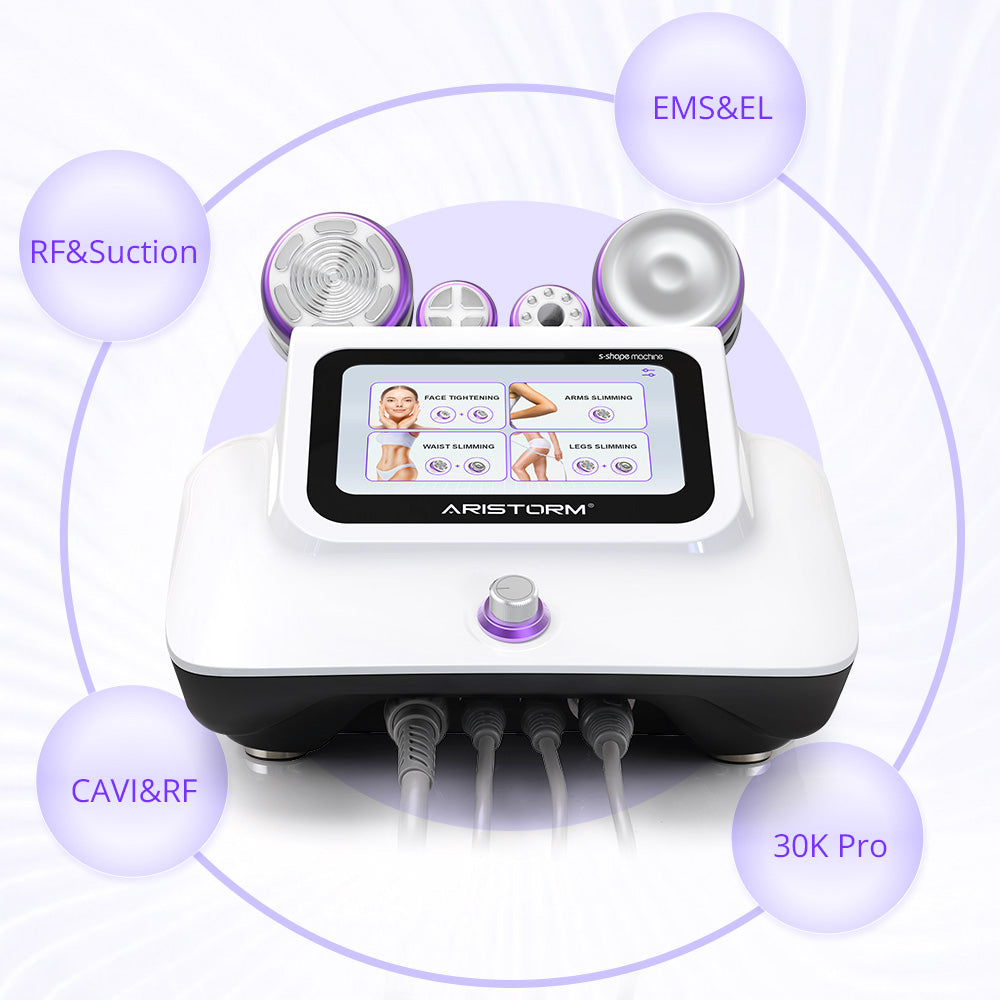Laser Lipo vs Cavitation: Which is Suitable for You?
In this article, you will know:
- Understanding Laser Lipo and Cavitation
- Laser Lipo Vs. Cavitation: What’s the Difference?
- Quick View of Laser Lipo vs Cavitation
- Can you do ultrasonic cavitation and laser lipo together?
- Laser Lipo vs Ultrasonic Cavitation: Which is Better?
We live in a world where having a sculpted body has always been one of the top aesthetic trends. From lifestyle changes to complex surgeries, there are numerous ways to achieve this. But what if I tell you you can get the body of dreams without going under the knife? Yes, it is possible with popular non-invasive options like laser lipo and cavitation.
If you're also thinking about getting one of these treatments, it's important to know how they're different. This article will compare every aspect of these treatment options. By the end of it, you will have a clear idea about which treatment is suitable for you.
So, without further ado. Let's read ahead.

Understanding Laser Lipo and Cavitation
What is Laser Lipo?
Laser lipolysis, known as laser lipo, is a minimally invasive fat reduction procedure. It utilizes laser energy to target and liquefy fat cells under the skin. The procedure is typically done under local anesthesia, so pain is out of the question.
With the help of laser lipo machine we insert a tiny laser fiber through small incisions. These fibers deliver energy directly to the fat cells. The energy will break the links between the fat cells, a process known as liquefaction. Ultimately, the liquefied fat is then either,
- naturally absorbed by the body or
- extracted through a small tube.
Tadaa! Your body is free of extra fat now.
What is Cavitation?
Cavitation, or ultrasonic cavitation, is a completely non-invasive body contouring treatment. Cavitation machine uses ultrasound technology to break down fat cells. During the procedure, a handheld device emits ultrasonic waves. These waves then create bubbles around the fat deposits. These bubbles burst, causing the fat cells to collapse and disintegrate into liquid. The body then naturally flushes out the liquefied fat through the lymphatic system.
Cavitation and Laser Lipo: How They Work?
Both laser lipo and cavitation are effective for fat reduction and body contouring.
Laser lipo is particularly beneficial for targeted fat reduction. It offers more precise contouring, as it allows for targeting specific fat deposits. In comparison, cavitation is best suited for larger areas. It is more about overall fat reduction than targeted sculpting.
Both treatments have shown promising positive results. However, their effectiveness can vary based on individual factors. Some important ones are body type, lifestyle, and the specific area being treated.
Suggested Read: How Much Does Laser Lipo Cost?
Laser Lipo Vs. Cavitation: What’s the Difference?
Principle and Theory
Laser lipo uses low-wave laser energy to target fat cells, causing them to break down and liquefy. This process, known as lipolysis, allows fat cells to be removed or absorbed by the body.
In contrast, cavitation utilizes high-frequency ultrasound waves to create micro-bubbles around fat cells. These bubbles collapse with enough energy to disrupt the fat cells. Ultimately, this turns them into a liquid form that the body can eliminate naturally.
Until now, you know well that both methods aim to reduce fat cells but differ in their approach.
"One uses laser technology, and the other relies on ultrasonic waves."
Effectiveness
The effectiveness of these treatments varies based on individual needs and body types.

Laser lipo is best for targeted fat reduction and detailed body contouring. It can specifically target small and stubborn fat areas, providing more precise results. Cavitation, on the other hand, is effective for reducing fat over larger areas. It is especially suitable for those who want to remove massive fat deposits from their body.
So, we can say that both methods are effective, but the choice depends on the
- specific areas of concern
- the desired outcome.
However, it's important to have realistic expectations, as unrealistic expectations lead to disappointments.
Using and Process
Laser lipo involves making small incisions in the area you want to treat. Then, a laser is put inside to melt the fat. It usually takes 1-2 hours, and you'll be awake during the procedure. However, you will not feel pain, only a mild tingling sensation. All of this is because laser lipo is performed under local anesthesia.
In comparison, cavitation uses a device that sends special waves over your skin. This treatment is quicker, around 30-60 minutes. Even though both of these are outpatient treatment options, you might need some time to rest after laser lipo as it is more like a small surgery. However, ultrasonic cavitation lets you go back to your normal activities right away.
Cost
The cost of having either laser lipo or cavitation can vary significantly. It depends on location, the skills of the caregiver, and the area being treated. Generally, laser lipo is an expensive option as it's like a small surgery and needs a professional. However, to give you a rough estimate, the average cost of a typical laser lipo session is around $1000 to $5000. Cavitation, on the other hand, is a more economical option. It only costs from $100 to $500.
Note: You might need to do these treatments more than once to get the desired results, which can increase the cost.
Suggested Read: How Much Does Laser Lipo Cost?
Safety
Even though Laser lipo is a safe procedure, it involves a few safety concerns. Some of the important ones are infections, bruising, and swelling. However, when performed by a qualified professional, these risks are minimal. Cavitation is safer because it's not like surgery. It might cause a bit of redness or warmth where it's done, but that usually goes away fast.

Suitability
The suitability of cavitation vs laser lipo depends on individual goals. Laser lipo is ideal for precise contouring and targeting stubborn fat areas. It's suitable for individuals close to their ideal body weight. And those who are struggling with specific pockets of fat. As we have discussed before, cavitation is more suited to reduce fat over larger areas.
Results
Laser lipo gives quick results, usually in a few weeks, as your body removes the liquefied fat cells. These results can be long-lasting, provided the individual maintains a stable weight. In comparison, cavitation takes more time. It needs several sessions over weeks, and the results show up slowly.
Ultimately, both treatments can reduce fat and contour the body. However, the results depend on the lifestyle choices you make. For example, maintaining a healthy diet and regular exercise is important to prolong the benefits.
Recovery and Downtime
Post-laser lipo, some downtime is expected. You usually need to rest for a few days to a week, depending on the extent of the treatment. In contrast, cavitation has virtually no downtime. Remarkably, it allows people to return to daily activities immediately after getting the body of their dreams.
Laser Lipo and Cavitation Side Effects
Both laser lipo and cavitation have their own set of potential side effects.
For laser lipo, common side effects include swelling, bruising, numbness, and discomfort in the treated area. These typically subside within a few days to weeks. Rarely, there might be more serious complications such as infection or uneven skin contours.
Cavitation's side effects are generally milder, including temporary redness, warmth, or minor bruising. Therefore, choosing a qualified practitioner for either treatment is important to minimize risks.
Quick View of Laser Lipo vs Cavitation
|
Factor |
Laser Lipo |
Cavitation |
|
Principle and Theory |
Uses low-wave laser energy to target fat cells, causing them to break down and liquefy, allowing their removal or absorption by the body. |
It utilizes high-frequency ultrasound waves to create micro-bubbles around fat cells, which disrupt and turn them into a liquid form for natural elimination. |
|
Effectiveness |
Ideal for targeted fat reduction and detailed body contouring. |
Effective for reducing fat over larger areas, suitable for massive fat deposits. |
|
Using and Process |
It involves small incisions and a laser inside to melt fat. It takes 1-2 hours and is performed under local anesthesia. |
Quick treatment with a device sending special waves over the skin, usually 30-60 minutes, with no incisions. |
|
Cost |
Typically expensive, ranging from $1000 to $5000 per session. |
More economical, it costs between $100 to $500 per session. |
|
Safety |
Minimal risks when performed by a qualified professional; risks include infections, bruising, and swelling. |
Generally safer with minimal risks, it may cause temporary redness or warmth. |
|
Results |
Quick results in a few weeks, long-lasting with stable weight. |
Slower results require multiple sessions over weeks. |
|
Recovery and Downtime |
Some downtime is expected, ranging from a few days to a week. |
Virtually no downtime and can return to daily activities immediately. |
|
Side Effects |
Swelling, bruising, numbness, discomfort, potential infection and uneven skin contours (rare). |
Milder side effects, including temporary redness, warmth, and minor bruising. |
Can you do ultrasonic cavitation and laser lipo together?
Traditionally, both of these treatments are used separately. However, some professionals may offer them in conjunction for enhanced results. The rationale is that laser lipo can precisely target and reduce localized fat, while cavitation can address broader areas, leading to a more holistic body sculpting effect.
Laser Lipo vs Ultrasonic Cavitation: Which is Better?
I have told you multiple times the basics of ultrasonic cavitation vs laser lipo. So, this time, repeat with me!
Laser lipo is good for targeting and reducing fat in specific areas. It works well for people who are close to their ideal weight but have stubborn fat. On the other hand, ultrasonic cavitation is better if you want a non-surgical way to reduce fat in larger areas of your body. It's also a more affordable option.
Your choice should be based on what you prefer, what you want to achieve, and your medical history. What I suggest is that you must consult with your healthcare provider. Talking to them can help you make the right decision.



Leave a comment